From Roy Troutman: “I shot a video back in 1991 of a 17 year Magicicada cassini singing right on my hand.”
From Roy Troutman: “I shot a video back in 1991 of a 17 year Magicicada cassini singing right on my hand.”
These are the 17 most interesting 17-year cicada facts (IMHO). All these facts apply to 13-year cicadas as well.
People call these cicadas “locusts” but they are not true locusts — real locusts look like grasshoppers. The phrase “17-year cicada” indicates that they arrive every 17 years. The name “periodical cicadas” indicates that they arrive periodically and not each and every year. The scientific name for the Genus of these cicadas is Magicicada, and there are 3 types of 17 year Magicicadas: Magicicada septendecim, Magicicada cassini and Magicicada septendecula.
This is a true locust:
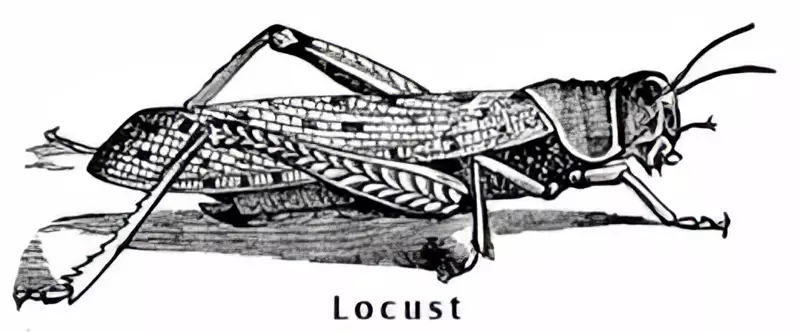
There are 13-year cicadas too! There are four species of 13-year cicadas: Magicicada tredecim, Magicicada neotredecim, Magicicada tredecassini, and Magicicada tredecula. Broods XIX, XXII and XXIII feature these cicadas.
Here’s a video that will help you identify the various species.
Most 17-Year Cicadas have red eyes, but they can also have white, gray, blue , or multi-colored eyes.
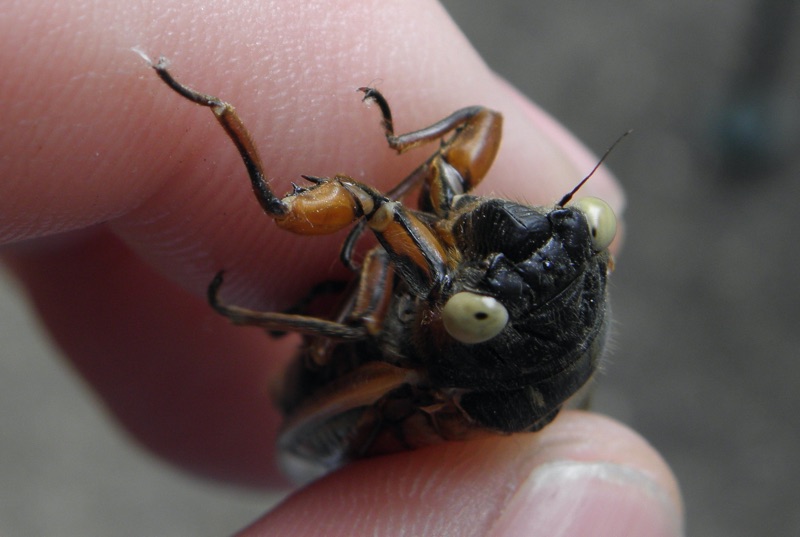
The Massospora cicadina fungus infects Magicicadas, destroying their abdomen and ability to reproduce. Often, their entire abdomen will fall off. The cicadas spread the fungus throughout their local colony via mating. The Massospora fungus is a cicada STD!
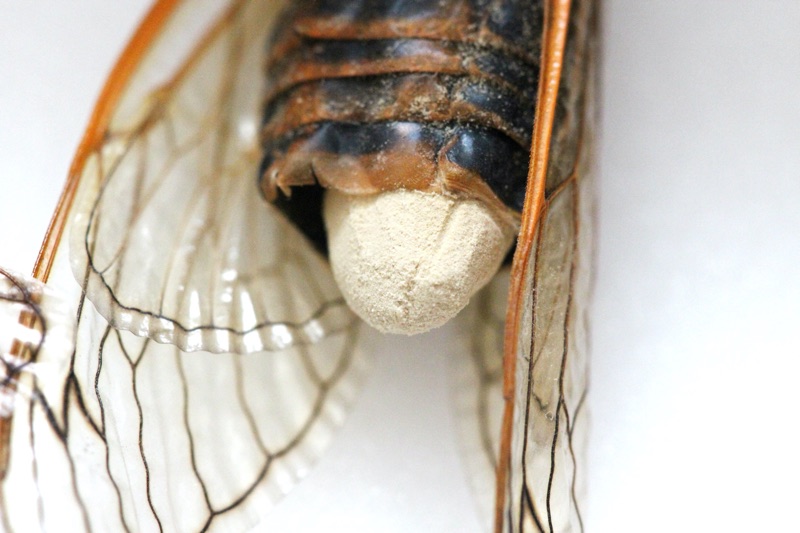
Cicadas think the sounds made by power tools and lawn maintenance equipment are made by cicadas. They get confused and will land on the people using the equipment! Pro-tip: cut your lawn in the early morning or near dusk when the cicadas are less active.

Cicadas have two, obvious, large, compound eyes, and three ocelli. Ocelli are three jewel-like eyes situated between the two main, compound eyes of a cicada. We believe ocelli are used to detect light and darkness. Ocelli means little eyes in Latin.
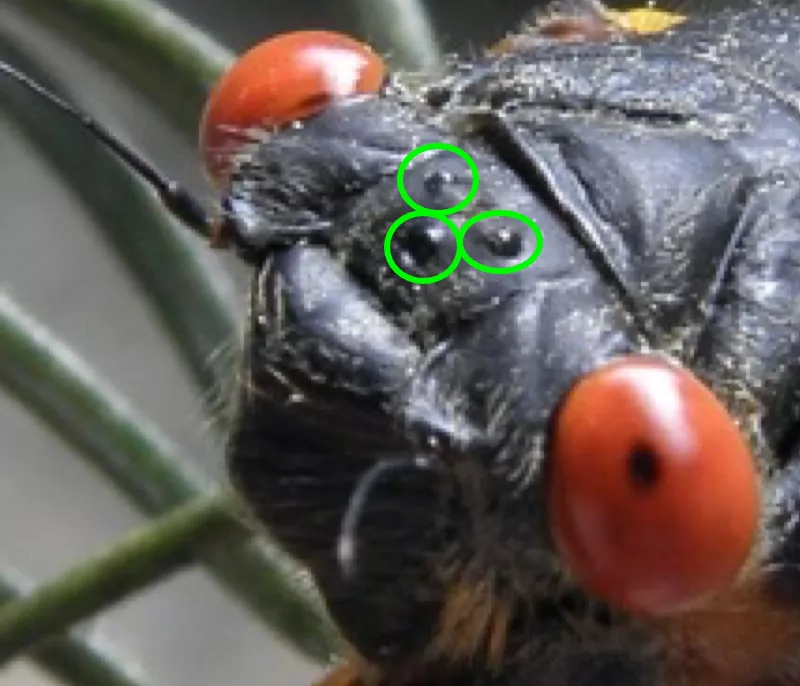
People eat them. You can barbecue it, boil it, broil it, bake it, sauté it. There, uh, cicada kabobs, cicada creole, cicada gumbo, panfried, deep fried, stir fried. There’s pineapple cicada, lemon cicada, coconut cicada, pepper cicada, cicada soup, cicada stew, cicada salad, cicada and potatoes, cicada burger, cicada pizza, cicada sandwich… that’s, that’s about it.

All wild animals and domestic pets will eat them. Dogs will gorge themselves until they choke. Squirrels will eat them like corn on the cob. Wild turkeys will grow fat and juicy on the cicada feast. Fish go crazy for them too — you can use them as bait, or use lures that mimic them.
Cicadas don’t eat solid foods like leaves or fruits. Instead they use their slender, straw-like mouth parts to drink tree fluids.
Yes cicadas pee, so wear a hat when walking under trees if that sort of thing bothers you. Cicadas drink tree fluids and then expel the excess fluid they do now need. People call it “honeydew” or “cicada rain”.
Only male cicadas make the loud sound they are famous for. Males have organs on their abdomen called tymbals. Muscles pop the tymbals in and out, which creates the sound we hear. Males make different calls for different reasons, and each species has a unique sound. Females can make sound too: they flick their wings to respond to males.
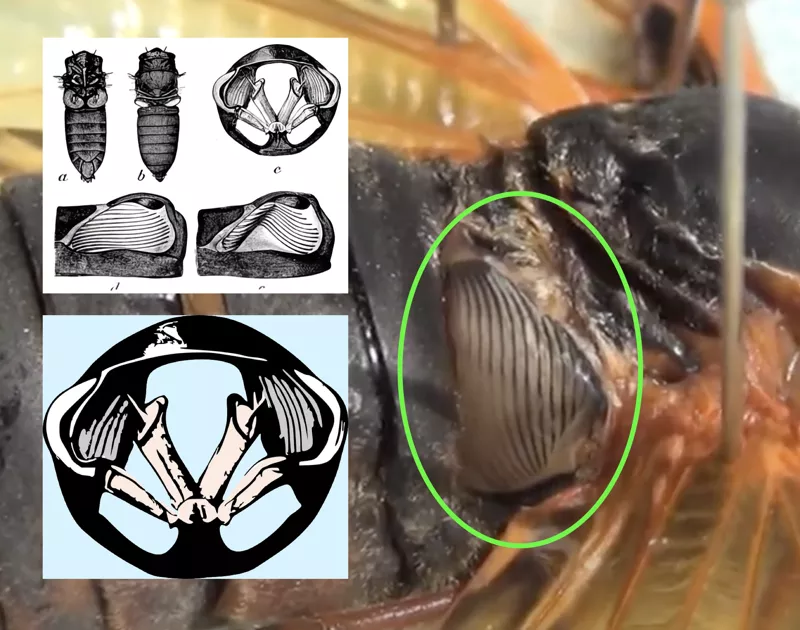
There are literally billions, if not trillions, of 17-year cicadas. Why? One theory suggests that a large number of cicadas overwhelms predators, so predators are never able to eat them all and cicadas, and many always survive to mate. This is a survival strategy called “predator satiation”.
The biggest concern about 17-year cicadas is their potential to damage young trees. The truth is they will damage limbs on the wimpiest of trees, so if you have weak, pathetic, wimpy ornamental trees in your yard you should consider placing netting around the trees if the cicadas visit your yard. Also, you can try hosing them off with water, placing insect barrier tape around the trunk of the trees, or picking them off like grapes! Or, plant strong, beefy American trees — that’s what I would do. Cicadas actually benefit the health of trees by aerating the soil around the roots and trimming the weak or damaged limbs.
Periodical cicadas that emerge in years before they are supposed to emerge are called stragglers.
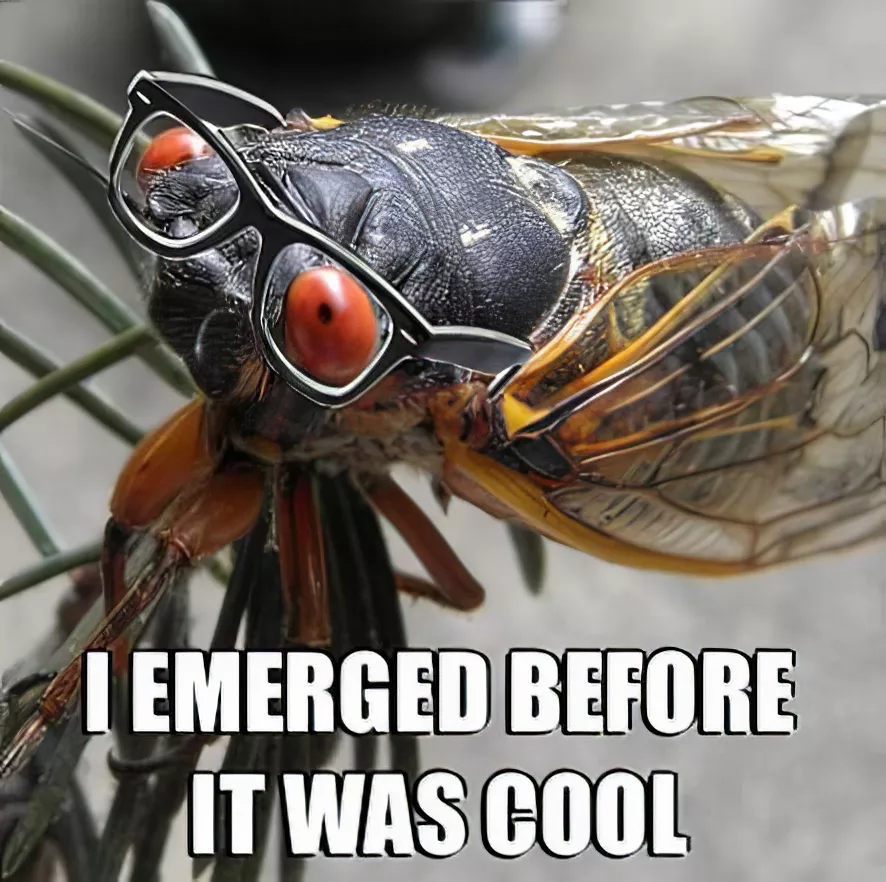
Scientist speculate that one reason why these cicadas emerge in 17 or 13 year cycles is because those are prime numbers. The fact that 13 & 17 are relatively large* prime numbers makes it difficult for predators to synchronize with them. (*Relative to the average lifespan of an animal.) Annual cicadas (cicadas that arrive every year) often have wasps specialized to prey on them; periodical cicadas have no such wasp because no wasp could evolve to synch with it.
Cicadas need to be warm to sing and fly around. Their dark skin absorbs the heat of the sun, which helps to warm them up.
Cicada Broods usually don’t overlap geographically, and it is very rare when they emerge in the same year. In 2024, Brood XIX and Brood XIII are both emerging.
###
If you have 18 minutes to spare, watch the video version of this article.
Here’s something neat. Roy Troutman discovered some Brood XIV Magicicadas emerging 4 years late in Ohio. That’s a “21 year cicada”. 🙂
Here’s the photos:
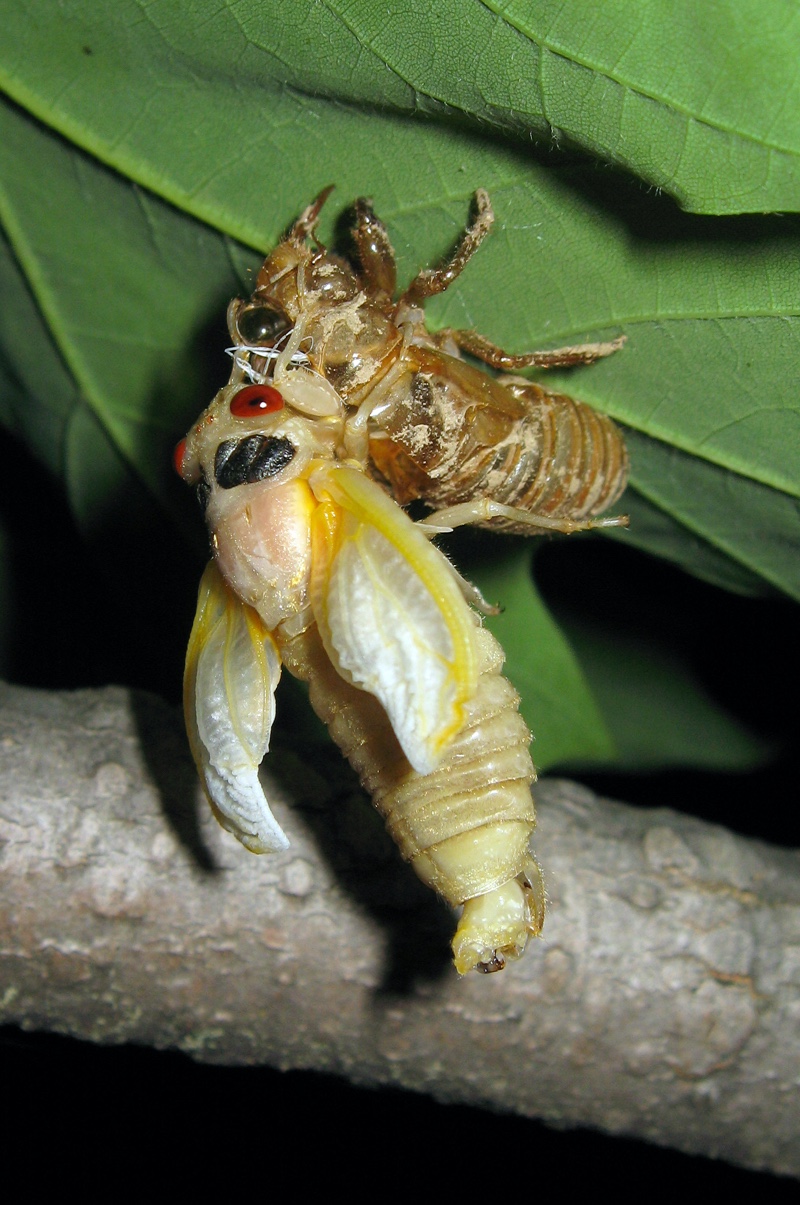
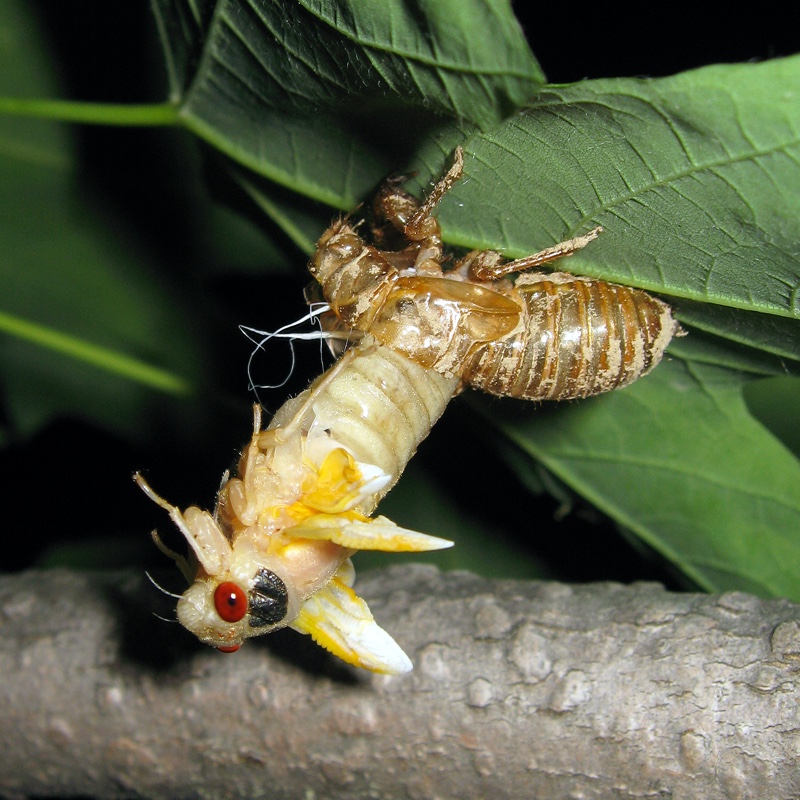
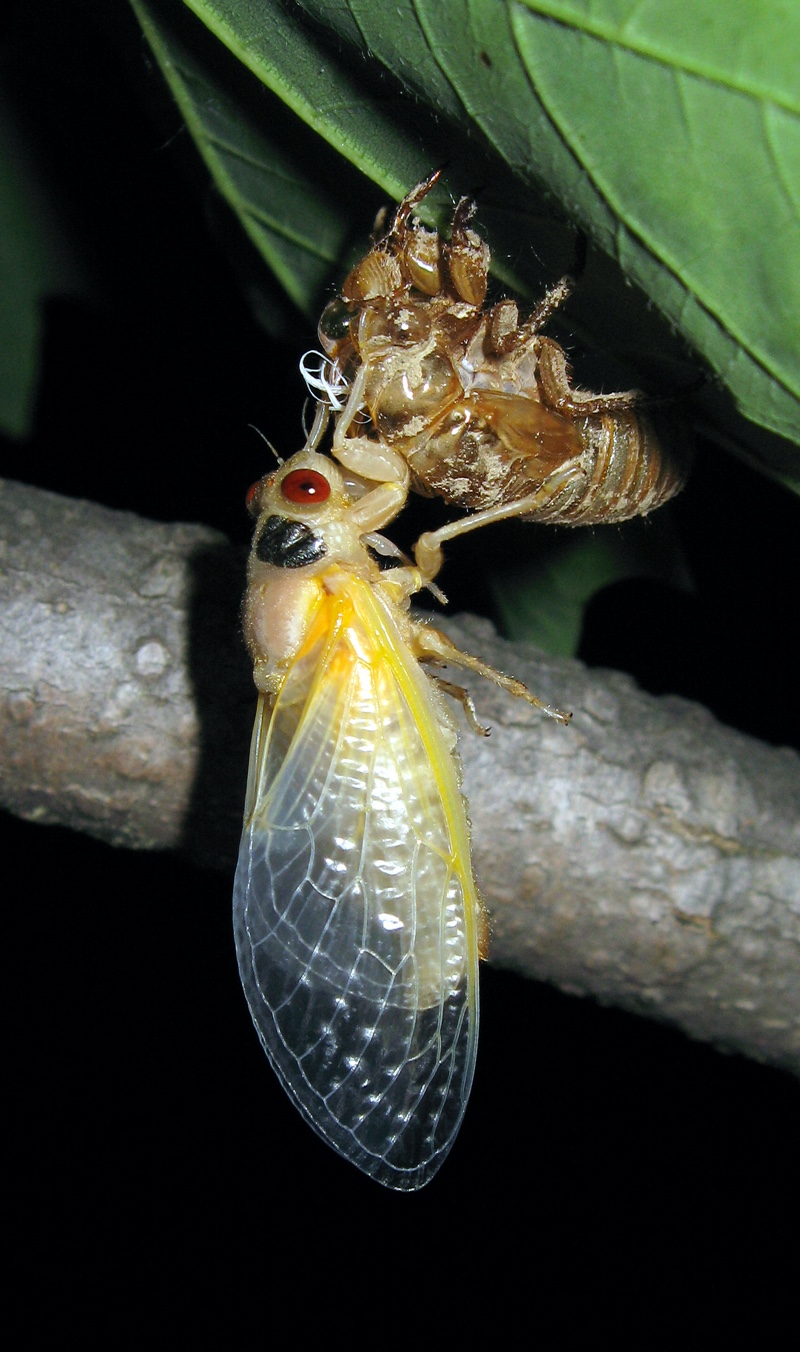
Gene Kritsky observed a similar unexpected emergence in 1995. See “The Unexpected 1995 Emergence of Periodical Cicadas (Homoptera: Cicadidae: Magicicada spp.) in Ohio”, Gene Kritsky and Sue Simon, Department of Biology, College of Mount St. Joseph, Cincinnati, OH. (OHIO J. SCI. 96 (1): 27-28, 1996). An excerpt from the article:

Roy Troutman found this Brood XIV Magicicada straggler in the Cincinnati Ohio area this weekend. This cicada emerged 2 years after it should have. Amazing.
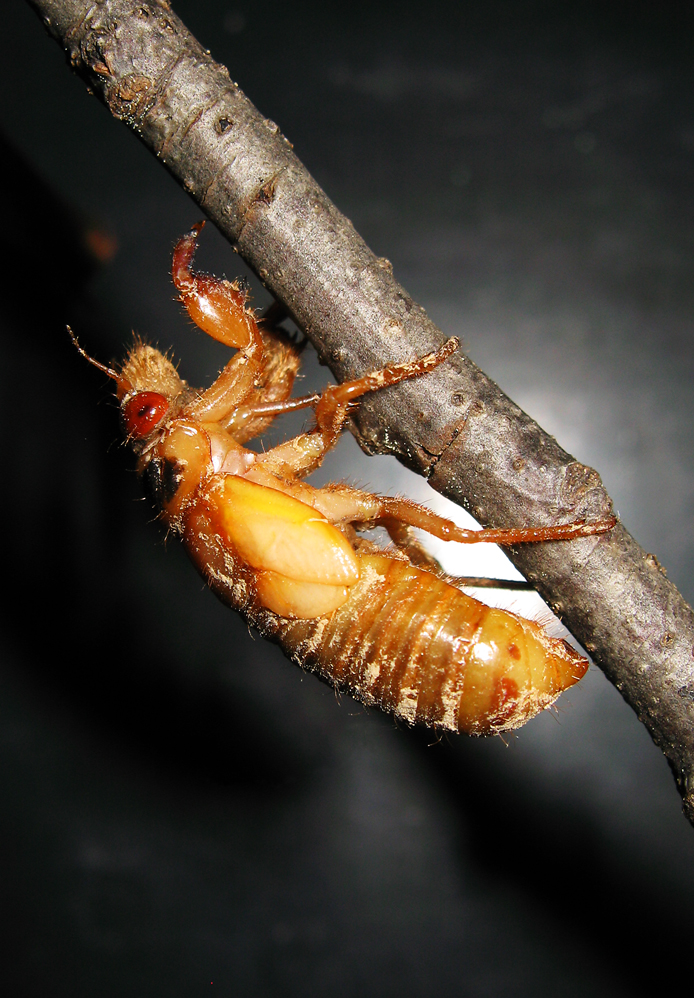
According to messages left on this site, as well as the magicicada.org map, Brood II cicadas have emerged in New Jersey and New York. I’m in New Jersey, and I plan on looking for cicadas this weekend.
So far:
Brood II stragglers are emerging (4 years ahead of schedule) in North Carolina, Virginia, Maryland, New Jersey and New York.
Brood XIV stragglers are emerging (1 year after they’re supposed to) in Ohio.
Update:
I found some skins in Metuchen, NJ tonight. Apologies for the quality of the photo — I only had my cell phone with me (cell phones were not good in 2008).
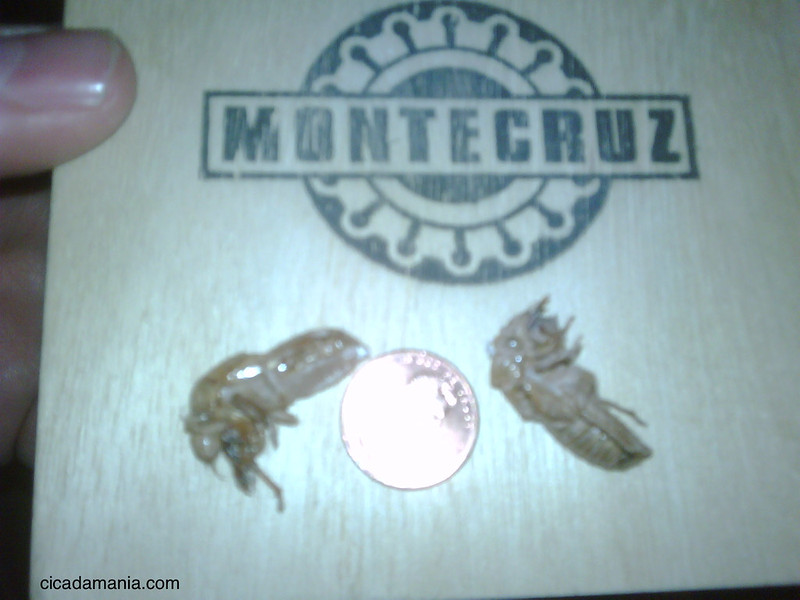
So, we already know that Brood II stragglers are emerging in places like North Carolina and Virginia. Brood II cicadas weren’t due until 2013, which means the Brood II cicadas emerging now are emerging 4 years ahead of schedule.
At the same time, Brood XIV stragglers are emerging in Ohio (Batavia, Ohio to be exact). Brood XIV emerged in full-force last year, which means some Brood XIV cicadas emerging now are emerging 1 year behind schedule.
If you compare the Brood II map and Brood XIV map you’ll see they don’t overlap. Hint: open each map in a different browser or browser tab and toggle between the two.
Here’s some pictures of the Brood XIV stragglers Roy Troutman found just tonight in Batavia, Ohio.
Tommy Joseph took these photos of Magicicada septendecim emerging Greensboro, North Carolina.
Update: looking at the maps, they probably aren’t brood XIV. Looks like they are Brood II accelerated 4 years, or Brood XIX accelerated 2 years (which would make them 13 year cicadas).
Big pile of skins:
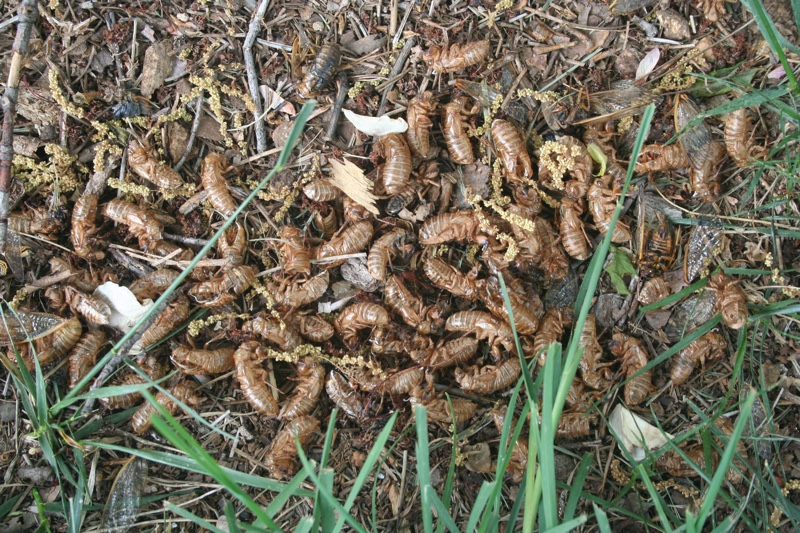
Magicicada with damaged wings:
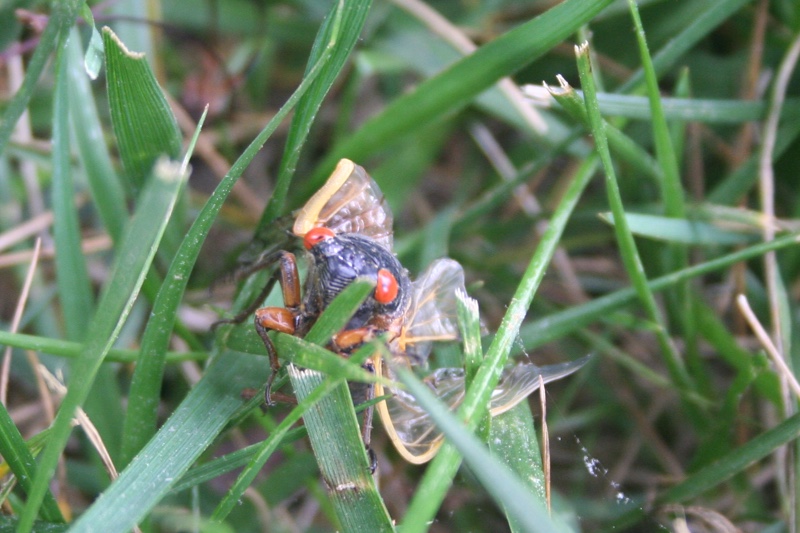
Adult Magicicada:
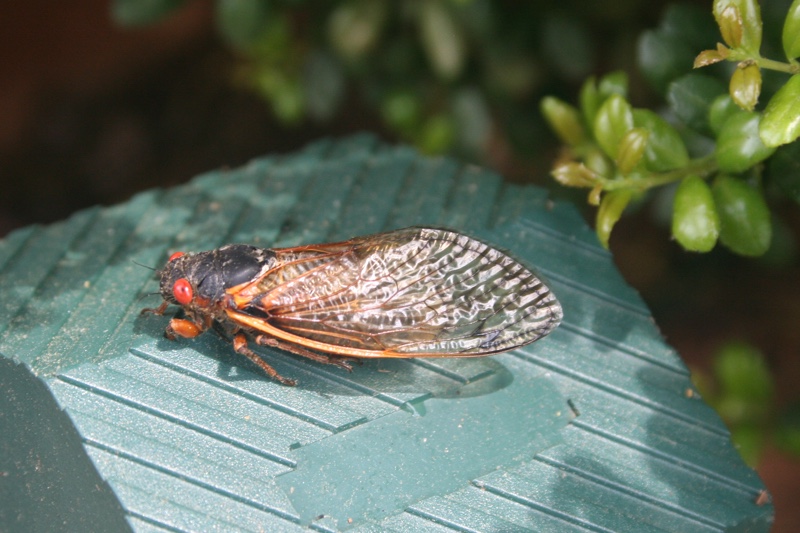
Exuvia/skin/shell:
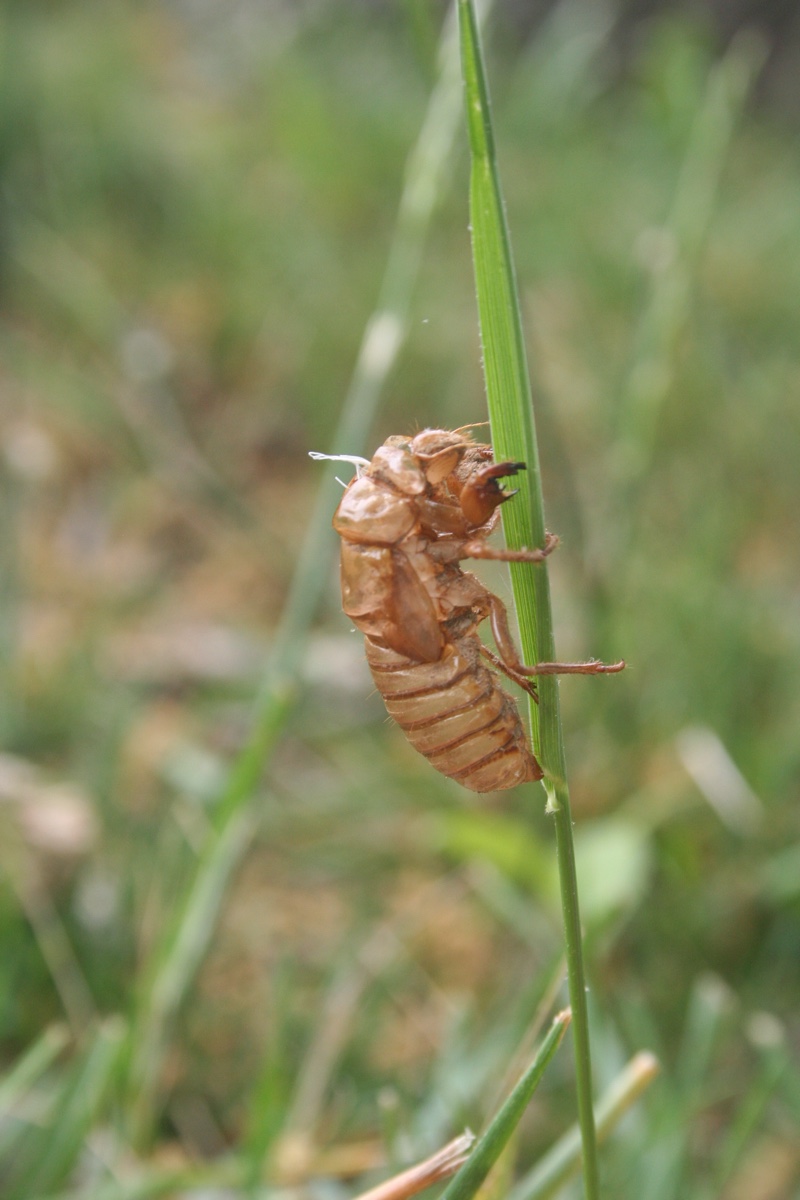
Male Magicicada septendecim:
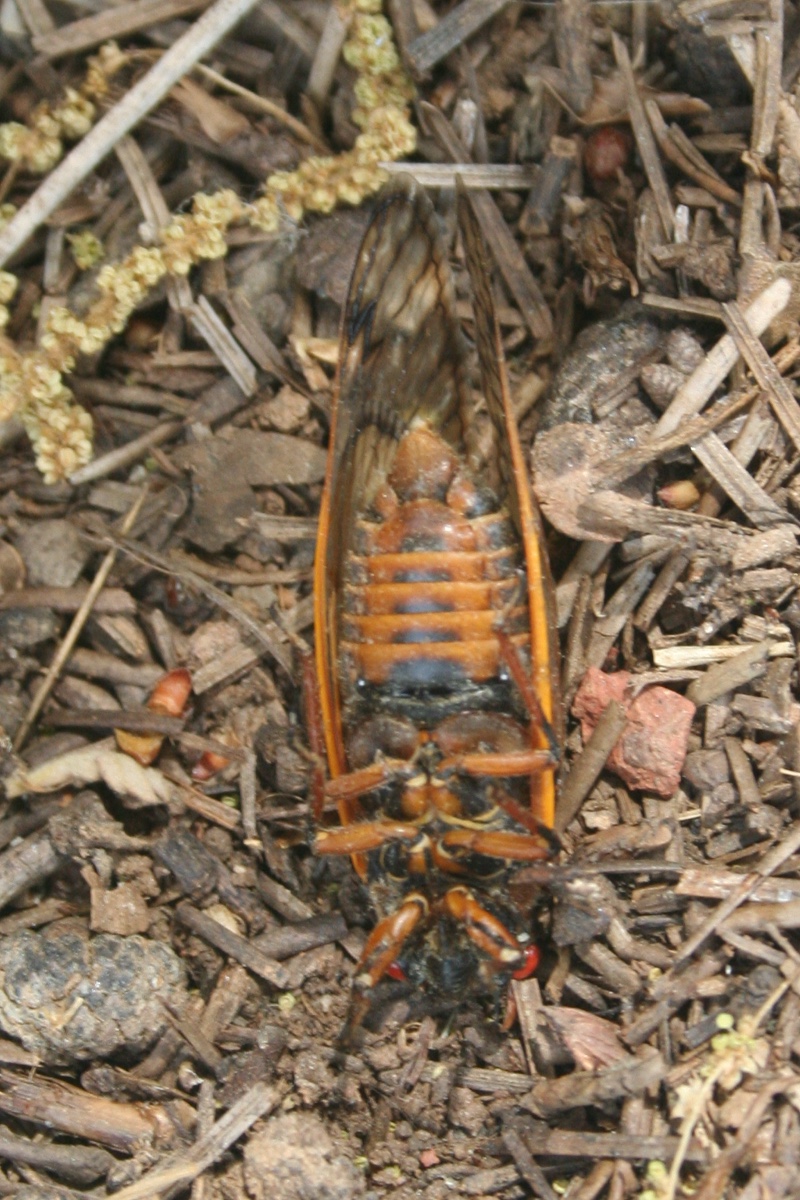
Exuvia/skins/shells on leaves:
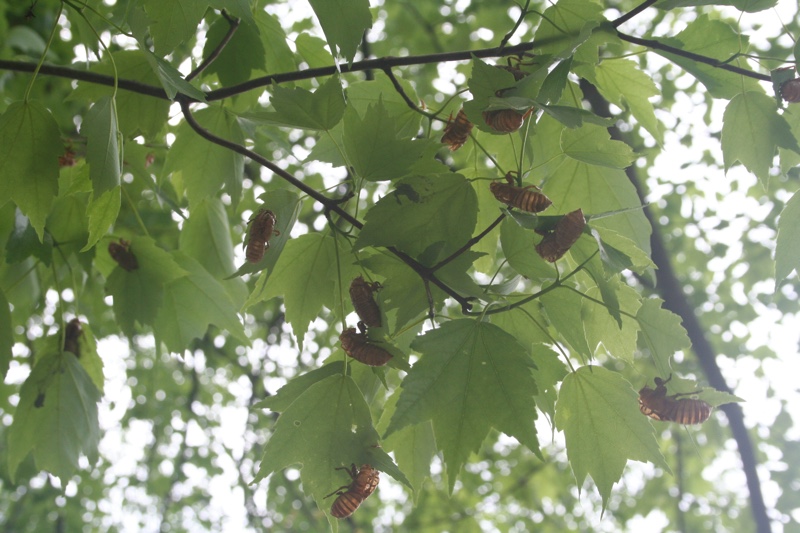
Be on the lookout for Brood XIV stragglers. A few Magicicada that didn’t emerge in 2008 should appear in 2009! Keep your eyes and ears peeled.
Here’s something special. Roy Troutman has uploaded some HD quality videos of Magicicadas to YouTube. Click the links to see the full-size versions.
Periodical Cicada sitting on leaf in HD:
Periodical Cicada’s heart pumping in HD:
Here’s a Brood XIV Roy created as well:
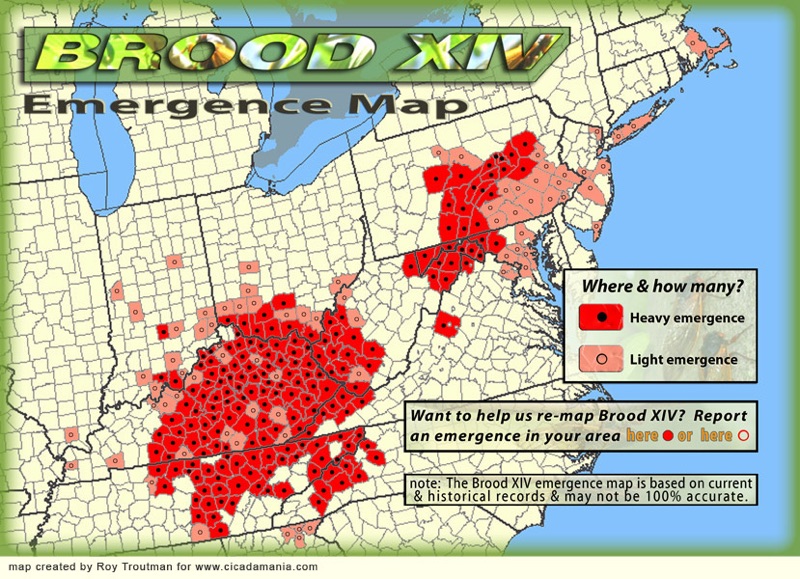
These questions come from the old General Cicada Questions message board. They are from 2008, so there is a good chance there are Magicicada Brood XIV questions interspersed. The questions and answers are in reverse order. URLs found in comments are old and likely do not work.
There are some sites on the internet detailing Thai cicadas. Additionally there is a book called Cicadas of Thailand by Bouchard, Volume I. This is the best text with multiple illustrations and a CD on Cicada calls. Hope that helped
Comment by Elias — November 21, 2008 [AT] 7:51 am
when will both cicadas come out?
Comment by tyler — November 15, 2008 [AT] 2:23 pm
Hello,
I have seen very big cicadas in Thailand recently which make sounds like very very loud sirens. Do you know, what they are called?
I could send you a photo!
Greetings from Andrea, Germany
Comment by Andrea — November 5, 2008 [AT] 1:21 pm
Sounds like Katydids.
Comment by Dan — October 21, 2008 [AT] 8:08 am
COuld they be Katydids? Check the sounds of insects site from an earlier post of mine and listen to the calls. Hope that helps. I do not believe any cicadas in North America sing at night. A few speices will call at late dusk however.
Comment by Elias — October 21, 2008 [AT] 7:27 am
Hi!
I live in Wisconsin. I’ve been hearing strange clicking sounds coming from the trees this past summer, and they seem to last all day and into the night. I’ve not heard these clicking sounds before, so I’m curious as to what insect may be producing these noises.
Can someone tell me what i’m hearing?
Comment by Robert — October 12, 2008 [AT] 6:41 pm
Hello Mckenzie,
Do you have pictures of this cicada? Please send them to my email epb471 [AT] yahoo.com. I am not sure if you are the “librarian” or Nathan. I would like to see both specimens to help with the ID.
Here in NY we have temps 50-60′s. Katydids and crickets still singing at night albeit slowly. Cicadas are all gone.
Elias
Comment by Elias — October 6, 2008 [AT] 3:57 am
Quote:
I would think as an answer to both Librarian and Nathan that the highest likelihood is Tibicen canicularis. Click on the link for a picture and call. http://www.musicofnature.com/songsofinsects/iframes/cicadas/popup_tibicann.html
End quote
I haven’t heard this call in my backyard before…
Comment by McKenzie — September 30, 2008 [AT] 9:51 am
Wow, still hearing a lone cicada this late in the year.
Comment by McKenzie — September 30, 2008 [AT] 9:48 am
Not sure if anyone breeds or sells cicadas. They have a long subterranean life cycle and are quite difficult to rear in captivity.
Comment by Elias — September 24, 2008 [AT] 11:59 am
hey guys
just wondering where i could find a breeder/seller of cicadas in southwestern ontario
thanks
jim
Comment by JIM VLAHOS — September 23, 2008 [AT] 7:13 pm
The Tibicen species have a 2 — 9 year life cycle which has not been fully worked out yet. They are not periodical like the 17 year cicada as a brood of Tibicen emerges every year. It has been observed that some years they are more plentiful then others. This species emerges as far north as mid Canada so they are likely better able to handle the cold. You are probably seeing the end of the emergence. It is interesting that they were males because usually the females emerge most commonly later on.
Comment by Elias — September 12, 2008 [AT] 6:58 am
Thanks, Elias, this looks like what I found.
Any ideas why they emerged and molted so late in the fall? We are soon to have frost, so I don’t think that there will be time for mating, egg laying, hatching, etc.
Did these guys just miss their cycle? (they were both males).
Thanks.
Comment by Nathan — September 11, 2008 [AT] 6:42 am
I would think as an answer to both Librarian and Nathan that the highest likelihood is Tibicen canicularis. Click on the link for a picture and call. http://www.musicofnature.com/songsofinsects/iframes/cicadas/popup_tibicann.html
Comment by Elias — September 10, 2008 [AT] 9:45 am
Hello,
Yesterday my son found two very recently shed cicadas in Eastern South Dakota. They had just shed and their wings were still shriveled up and green. I didn’t know anything about them, so I have been doing some internet research. It doesn’t seem that these would be the 13 or 17 yr. species. It has been pretty cool for the last several weeks, into the 40s and 50s at nights and 60s during the day although yesterday was in the upper 70s. Any ideas as to why these emerged so late and what year they would have hatched? They are green and black like a frog and the leading edge of their wings is bright green. Thanks.
Comment by Nathan — September 10, 2008 [AT] 6:54 am
NEW YORK RANGE IDENTIFICATION
Can someone tell me what species of Tibicen would be in the Albany, NY (Niskayuna area specifically) locale?
Thanks.
Comment by Librarian — September 9, 2008 [AT] 6:06 am
Here’s a link to a story about cicadas that have landed in Buffalo!
http://buffalorising.com/story/the_cicadas_have_landed#sca
Comment by David — September 8, 2008 [AT] 1:52 pm
Greetings all:
I am looking for any information on the location of Tibicen auletes on Long Island or Staten Island, New York.
Please review this picture/call of T. auletes. They like sandy soil and oak trees and call mainly at dusk.
http://www.musicofnature.com/songsofinsects/iframes/cicadas/popup_tibiaule.html
Please tell me what town or nearby place you hear them or you can email me directly at epb471 [AT] yahoo.com. The goal is to update nearly 100 year old databases on this elusive species. Thank you!! ELIAS
Comment by Elias — September 7, 2008 [AT] 6:50 pm
Hello Darvin,
I would think that the larvae are probably the immature forms of another insect. The cicada undergoes an incomplete metamorphisis, sheds its shell and flies away. The eggs are laid in branches and they fall to the ground and burrow in. Cast of shells do not have any further role in a cicadas life cycle. I am sure in a very heavy periodical emergence, some new nymphs could by chance fall on to a cast off shell.
Take care and hope this helped
Elias
Comment by Elias — September 5, 2008 [AT] 3:04 pm
We live in Minnesota, and we have found alot of Cicada “shells” around our maple tree this summer. My daughter found two of these shells and put them in a container to take to school to show her class. After two or three days she brought them to me and said that there were worms in the shells. Sure enough — there were two small white larvae crawling out of the shell. I didn’t know that that was part of the life cycle. The next day there were larvae crawling in the second shell. Have you come across this situation before? Cicada are amazing!
Comment by Darvin Ische — September 5, 2008 [AT] 7:50 am
NEW!!! Joe Green: Tibicen resonans, Florida, 2007
The pictures here are most like the cicadas here. They’re mostly black with a little bit of green though. They’re wings are loooong and they fold behind them. They’re not as active at night as they were…my husband and I quit smoking though so we haven’t been outside much at night. We did go outside one night this past weekend and there was one still alive on the ground and one ran into the porch light and then tried to get me, another ran into the end of our house and flew above it. They sing all day here all year round. Since I moved to east Texas from south Texas I’ve heard them every day but I’ve only seen the shells left behind until I moved here to Winnsboro. There aren’t any more shells around than normal…I guess they’re just getting a bit more brave…or could clearing of the woods behind us stir them up??
Comment by Ashley — September 4, 2008 [AT] 8:57 pm
Yes, Steve, it would be very interesting to see your photos of cicadas in Israel!
Comment by Bob Jacobson — September 1, 2008 [AT] 7:37 pm
Someone told me that cicada’a in Austrailia sing at night. i saw your page that says that is generally not true. i told the person that they were hearing treetoads or crickets but not cicadas.
also i took close up photos of cicadas in israel. anyone interested?
please reply to:
listed [AT] bible.ca
Steve
Comment by steve — September 1, 2008 [AT] 6:05 pm
GREEN GROCER
JAPANESE TSUKU TSUKU BOSHI
Has anyone a recording of a green grocer cicada?
I can find many others on the web, but not that one.
Here, by the way, is a Japanese tsuku tsuku boshi cicada—>
Very distinct sound (like a bird)
PICTUE
http://pds.exblog.jp/pds/1/200508/25/90/e0038990_1641244.jpg
AND MANY MORE
http://homepage2.nifty.com/saisho/cicadasongaac_e.html
Comment by Paul Arenson — August 31, 2008 [AT] 3:37 pm
It is atypical for the nymphs to shed in the daytime. I am not sure if this leads to a higher deformity rate. Also it may have been stuck during the molting process and you found it at a later time. If the emerging portion of the cicada was black already than this was the case.
Unfortunately alot can go wrong during that final molt! Once they are stuck there is nothing that can be done to help them.
Comment by Elias — August 31, 2008 [AT] 9:18 am
Hi! This morning as I was out walking, I saw a cicada nymph in the street. It was clinging to the pavement and had begun shedding, but I didn’t want it to get run over by a car, so I picked it up and carried it to a safe spot. I know it was alive, as I could feel little spasms or jerks from its body as it tried to get the old shell off. However, it never continued shedding after that point; it died soon after. Did it die because its shedding process was disturbed? Or perhaps it had already become overheated in the morning sun when I found it? I’m sad that the lil guy didn’t make it..
Comment by Colleen S. — August 30, 2008 [AT] 4:06 pm
I wish I could send pics, but I don’t have a camera. I can say that there have been a couple that fell from a high tree and hit the roof, then fell to the ground. The others all had sufficient climbing surfaces. Many, which I forgot to mention, were almost entirely black in coloration, the darkest ones tended to have the worst wing deformation..
Thank you, by the way, for responding to my inquiries. 🙂 They are Very much appreciated!
Comment by bugwhisperer — August 28, 2008 [AT] 7:39 pm
The less choices that periodicals have in terms of vertical surfaces, the higher the deformity rate. They trample and mash each other. Somehow enough usually survive. Also if there is undergrowth the deformed males can call and mate with deformed females. I have witnessed this on several occasions.
Comment by Elias — August 28, 2008 [AT] 7:01 pm
This seems reasonable to me. One can often find deformed periodical cicadas, too.
Comment by Bob Jacobson — August 28, 2008 [AT] 3:19 pm
There exists the possibility that the cicadas where injured during their shedding process. When this occurs, they may bleed (technically endolymph)and this creates dark blotches or spots. This can be seen if the nymph falls far onto a hard surface or if it is attacked by another insect/arachnid, or sometimes from other cicada nymphs trampling a shedding nymph on its way up a tree. Just a theory based on what you gave us. What does everyone else think. Please send pictures so we can see.
Comment by Elias — August 27, 2008 [AT] 4:33 am
Hi! I had no idea this website existed, this is so awesome!!! Question. I live in central Indiana and have noticed some type of epidemic with the population this year. I have found several with black spots whose wings will not fully develope, also covered in black spots. ALL of them have died. It’s almost as if their wings are stuck together. These friendly buggies are very dear to me, but I don’t know much, in fact I just saw my first attack by a ‘killer wasp’ yesterday. If anyone has an expaination I would appreciate it, because it breaks my heart everytime I find one.
Comment by bugwhisperer — August 24, 2008 [AT] 7:48 pm
That’s not true. Cicadas stop singing a dusk for the most part. Katydids and cicadas keep chirping into the night.
Comment by Dan — August 23, 2008 [AT] 8:35 pm
My sister swears that the cicadas stop singing at 2AM. Is that true? If yes, why?
Comment by Kathleen — August 23, 2008 [AT] 6:08 pm
Hello Cress,
I am postive the cicada killer venom lasts for the remaining life of the cicada. I have collected many specimens by gently tugging them away from female cicada killers when they are making their final approach to the burrow. I have never been stung in the process. All of my specimens never “woke up”. They will last approximately 5 — 8 days which is the lifespan of the cicada killer larva. If the cicada dies and spoils, so does the larva. Unfortunately, your friend wont come out of it, and I do not believe a known antidote has been developed.
I am also a huge admirer of Tibicen chloromera!
Comment by Elias — August 23, 2008 [AT] 6:14 am
Hey everyone,
I’m a *HUGE* fan of tibicen chloromera, I think of them as good friends. So imagine my shock and horror when I heard the sound of a distressed male as he landed to the ground being attacked by a cicada killer! I get that they’re beneficial and all but I took this as my one chance of being a cicada hero. I got the killer to leave without much effort and gently scooped my friend up to take home. He’s definitely paralyzed and has been chilling here for the better part of 6 hours. Concerned he was in pain and I was prolonging release I searched cicada killer venom to find it shouldn’t cause pain. But I can’t find any source that tells me how long the venom remains effective. Does anyone know how long my friend will be stuck like this?
Comment by Cress — August 22, 2008 [AT] 12:32 pm
Hello Mar,
Not much we can do except preserve woodlands and neighborhood trees. They are more often heard then seen so it will take a little diligence to find them. Trying to find a nymph at night and watching it emerge from its “shell” is the easiest way to acquire specimens. Good luck
Elias
Comment by Elias — August 22, 2008 [AT] 4:21 am
Hi, this is an awesome site!
I have Cicada singing in my garden, but, and I’m embarrassed to admit this, I can only find one so far to look at! (In the maple tree)
I have seen two Cicada killer wasps (I think; they’re large solitary wasps) they are pleasant, (like the Euro paper wasps who nest in the window well) and curious, (there might be more than two, but honestly the markings seem like the same two) but so far I haven’t seen any predation. I know it’s nature and the wasps have to eat, honestly I’m glad. Is there anything I can do that would help the Cicada (and his friends I can’t find) in my garden?
Comment by Mar — August 19, 2008 [AT] 6:52 pm
Does anyone out there collect cicadas, or is anyone interested in exchanging specimens? I’m trying to build a representative collection of as many different species as I can. Even specimens found dead on the ground would be of interest. (Ashley, I’d love to see what kinds are pestering you in Texas!)
I’m particularly interested in such species as Tibicen texana, robbinsoniana, similaris, resh, resonans, superba, figurata, bifidus and cultriformis, but they are all of interest, including other genera such as Okanagana and Diceroprocta. I’ll gladly pay postage for reasonably intact dead cicadas anyone is willing to send.
Thanks,
Bob Jacobson
jacobsonbob [AT] yahoo.com
Comment by Bob Jacobson — August 19, 2008 [AT] 4:18 pm
2 general questions, has anyone in New York heard T. auletes. I hear they are present in Staten Island and have confirmed them calling in Wading River (not large population however).
Second — anyone in NY seeing first instar Magicicada yet?
Comment by Elias — August 18, 2008 [AT] 4:03 am
Glad that worked out Ashley. It is strange for them to move around at night. They might have been freshly emerged from dusk and decided to take flight. The explanations are countless. Look forward to a picture and video this “bug dance” so all member could see a unique human — bug intereraction — ha ha! Keep us posted, and enjoy your weekend!
Elias
Comment by Elias — August 16, 2008 [AT] 4:15 am
Hello Elias,
I’m not scared of them persay, just don’t like bugs at all! I havent seen any in about a week so I think we may be fine. I still hear them in the trees. They just don’t come flying at us at night anymore. Thanks for your help! If I see one again I’ll try to take a picture of it while I’m dancing around doing the “bug dance”. 🙂
Comment by Ashley — August 15, 2008 [AT] 9:14 pm
Hello Ashley,
They fly randomly and will zig zag during their course. Nothing attracts them from a scent based perspective. Some cicadas are attracted to very bright lights at night, which is not your case.
You may just be experiencing a strong emergence which makes your probability of meeting them in flight much higher than average. When I saw the periodicals, I had 6 land on me at once. They are harmless and will not bite or sting you. The males will make a loud, screeching “alarm squawk”. Please send a picture if you can. Hope this helps. Knowledge always reduces fear 🙂
Comment by Elias — August 15, 2008 [AT] 8:43 am
Elias,
I just need to know what they’re attracted to so that I can minus that factor out and hopefully they won’t come get me! lol For some reason I just can’t stand the bugs!! When my husband had it’s wing, it had like a screaching, screaming kind of a sound.
Comment by Ashley — August 14, 2008 [AT] 9:34 pm
Hello Ashley,
Please do not murder the cicadas. They are harmless! You may be experiencing a particularly strong emergence. Can you describe the call they make. Also if you could send a picture to the site it would be interesting. Thanks and good luck
Comment by Elias — August 14, 2008 [AT] 4:29 pm
I live in east Texas, about 2 hours east of Dallas. I’m positive their cicadas. Everyone here calls them locust which I looked up and locust are actually like grasshopper things. I’m not sure why, but they’re definately cicadas. They look exactly like the pictures and they leave the little shells everywhere. They don’t necesarily “attack” me, they just fly into me a million times before they hit the ground. I’ve never in my life seen so many of these things!!! We were sitting outside this past weekend for about 2 hrs and my husband killed 6 of them! They make that awful clicking sound thing and everything. 🙁 They freak me out!
Comment by Ashley — August 14, 2008 [AT] 9:46 am
Ashley — what state do you live in and are you sure these are cicadas??? They rarely move about at night.
Comment by Elias — August 12, 2008 [AT] 7:33 pm
I have a million cicadas at my house and they “attack” me at night when I’m sitting outside. What are these horrible disgusting things attracted to?????? Is there any way that I can keep them away from me???? Help PLEASE!!!
Comment by Ashley — August 12, 2008 [AT] 1:21 pm
The drought probably is affecting them. Also some sepcies are proto periodical, meaning they experience larger numbers in some years as compared to others. Okanagana rimosa is known to have 4 year variations in emergence numbers. I hope they come soon. Last summer was like that here in NY. The numbers of the annual species were quite weak because of unusually cold weather we had.
Comment by Elias — August 7, 2008 [AT] 8:09 pm
I always look forward to the cicada’s song this time of year. It’s a sign of the changing seasons. However, this year, I have not heard it’s song?!! I live in South Minneapolis, MN. We are currently in a modest drought and I’m wondering if this may be the cause of the silence.
Comment by Jeanne — August 7, 2008 [AT] 5:26 pm
Hello Jo
Cicada Killers are large wasps that are actually quite harmless. You are probably on a lek which is a cicada killer colony. They will not bother you and only the females can sting. They will sting only if grabbed. I would be interested in seeing the cicada killer sites if you are inclined to tell me. I live in Queens county and am studying cicadas on Long Island. They bring in members of the local species and specimens can be taken for study.
They can paint a better picture of what species live in your area. As far as exterminating them, most exterminators do not have a good solution as each digs a burrow and they solitary. Hope this helps. Email epb471 [AT] yahoo.com if I can check out this colony. Thanks!
Comment by Elias — August 6, 2008 [AT] 4:36 pm
We are having a problem in Smithtown, NY with killer cicadas. They are ruining my lawn and my neighbors lawn. Who do I call about this nuisance?
Comment by Jo — August 6, 2008 [AT] 3:44 pm
Dan, Thanks for your help. I haven’t seen what ever it is making the noise just heard it. It was driving me nuts as I didn’t think cicada were to be found this far west. Again, thanks for you help.
Comment by Janice — August 4, 2008 [AT] 9:39 pm
Cicadas are definitely found in California. Locusts by the way are grasshoppers — not cicadas. People mistakenly call cicadas “locusts”, but they are not the same insect. This is a picture of a locust https://www.cicadamania.com/cicadas/2007/03/18/when-is-a-locust-not-a-locust/
Here’s an example of a cicada from California: https://www.cicadamania.com/cicadas/2006/06/02/okanagana-rimosa-from-carlsbad-ca/
Comment by Dan — August 4, 2008 [AT] 7:24 pm
Can anyone tell me if Cicadas or locust are found in California (norhtern Los Angeles area to be exact)? This summer I have been hearing a sound that that is very similar to the sounds I would hear growing up in SouthWest Louisiana during the summer…which were always Locust. I can’t recall hearing it previous to now in the five years I have lived here.
Comment by Janice — August 4, 2008 [AT] 3:24 pm
Hi, does anyone here have specimens of magicicada, they are willing to trade?
you can write me at:
c_raynault at hotmail.com
of course replace the at by [AT] .
I have been looking for specimens for a while. I Can’t find any. Only 2 dryed would do the thing but I can take more.
I prefer specimens in good conditions with their collecting data.
I am willing to do both buying and exchnaging.
Comment by jarl — August 4, 2008 [AT] 6:04 am
http://insects.ummz.lsa.umich.edu/fauna/Michigan_Cicadas/Michigan/Index.html
This should come out better. I meant to say “PINCH” not “pich”
Comment by Elias — August 1, 2008 [AT] 3:37 pm
Hello Blaine.
Cicadas do not sting. The only time it may “pich” you if you let it rest on your hand for a long time and it will try to feed on your finger with its beak thinking you are a tree branch! They do not mean to do this.
Perfect site to ID your cicada is Cicadas of Michigan.http://insects.ummz.lsa.umich.edu/fauna/Michigan_Cicadas/Michigan/Index.html
Hope that helps,
Elias
Comment by Elias — August 1, 2008 [AT] 3:36 pm
Hi, I am new to the Cicada craze, but I have always been intrigued by insects and spiders. Today, I found a Cicada of the following description laying on the ground on its back motionless. When I tried to pick it up, it started buzzing. It has one torn large wing on its back. The underbelly is mostly white, with a large set of bumps on the front two legs. The top of the Cicada is a dark army green. The wings are also army green. OOOH, I let it out of its bottle and it lifted its rear and a stream of clearliquid squirted out. I have been handling it a lot, so it must be a male as I wasn’t stung at all. Bay City, Michigan 48708
Comment by BUGMAN BLAINE — July 31, 2008 [AT] 12:00 pm
Yes Cathy they look the same because they’re the same species.
Yes they broods are based on the years they emerge.
All this information is in the FAQs, throughout the site, or other cicada sites.
If you want good books, look at the books section along the left side of the homepage.
Comment by Dan — July 31, 2008 [AT] 4:11 am
In addition, the sounds of insects site that Elias recommended in his post on July 23 is really good. I heard a zapping sound tonight and I located it on that site as a kaydid, of which I have found several in my yard. I’ve also been hearing a really annoying sound and I found that one also on that site — it was listed as a type of cricket.
Comment by Cathy — July 30, 2008 [AT] 10:47 pm
I just looked at the pictures of Brood X and Brood XIII. They look exactly like Brood XIV. Are they named different broods because of the different years that they emerged or because of the different places they emerged? If so, what happened to Brood XI and Brood XII? This may be a silly question but I’m really curious — how do they determine what brood they are going to call it and, if there are differences in the broods — what are they? Also, I teach first grade and when I showed my students on the computer back in May and June the cicadas they were totally fascinated by them. Does anyone know of any good sites for teachers that would list books, videos, games, activities relating to cicadas — and for that matter, insects in general? Thanks for any info you can possibly give me. Cathy
Comment by Cathy — July 30, 2008 [AT] 10:39 pm
Hello Cathy,
You are definitely getting braver. Cicada killers are very docile despite their fierce appearance. Female cicada killers (generally much larger than the males) can deliver a sting if grabbed. Males (generally smaller) are incapable of stinging. In addition to size, the female has larger spurs on the hind legs. You can actually collect cicadas from a cicada killer by placing a stick into its burrow. When a female returns with a cicada, it cannot get in. The technique is to grab the cicada by its wings and pull quickly parallel to the ground. You asked…. LOL!
Comment by Elias — July 30, 2008 [AT] 10:21 am
I almost caught a cicada killer. I held it down with the skimmer pole net for a few minutes. But when I went to slip a container under it for it to go into, it escaped. Do these things sting you? If I am able to catch one, I’ll save it for you Elias.
Comment by Cathy — July 30, 2008 [AT] 9:22 am
Quick update — TIBICEN AULETES has been located. I think the last T. auletes updates were from Davis himself between 1917 — 1026. Wildwood state park in Wading River, eastern Long Island, between 8:05 — 8:30PM, admist an incredibly loud T. lyricen chorus, I heard T. auletes for the first time. I caught a nymph too but I think it will turn out to be lyricen. (dark eyes, medium sized). Anyone know if T. auletes prefers a certain tree to feed on as nymphs?? More to follow…..
P.S. Cathy, nice to finally meet you today. Welcome to the cicada enthusiast world!!
Comment by Elias — July 29, 2008 [AT] 8:51 pm
Hello Edward,
I checked the http://www.thaibugs.com/cicadas.htm site and the sound files dont work, but the pictures are still fantastic. Here are some sites that may help:
Thai cicadas at sunset.
Best site here: Songs of South East Asian Cicadas. Mostly Malaysian which is geographically close:
http://www2.arnes.si/~ljprirodm3/asian_cicadas.html
Best for Thai cicadas only is Michel Boulard’s Book http://www.selectbooks.com.sg/getTitle.cfm?SBNum=41772
It has a CD on all the acoustic characteristics of Thai Cicadas.
Hope that helps. Tot Ziens!!
Elias
Comment by Elias — July 29, 2008 [AT] 8:46 pm
L.S.,
I thought that there was a file of the singing of a tibicen out of Thailand. Very loud. Can not find it now. Were is it?
Regards
Edward Koldewijn
Amsterdam
Comment by edward koldewijn — July 29, 2008 [AT] 11:11 am
Just drove out to Riverhead and made my way west looking for signs of T. auletes. Heard T. lyricen and T. linnei call. Maybe its to early for auletes here, not sure.
I went back to Lilco Road where I thought I heard Okanagana and I heard the same noise. I thnk I was duped by the power lines. This was most likely not Okanagana.
In response to Cathy’s post, drove by Brookhaven (William Floyd Parkway) and the flagging is unbelievable. This was one of the densest emergences on Long island. Looking forward to seeing first instars soon.
Tomorrow should be warm and I am off from work. Lets see what we can find….
Comment by Elias — July 28, 2008 [AT] 8:47 pm
wcbstv.com also has an article and a video, both dated June 12th about the cicadas here in my town of Coram. They’re interviewing on the intersection of Penniquid and Winside Lane which is where I live. Although I didn’t see any cicadas on Penniquid — just on Winside. It’s a cool video — you can see them flying around and they’re even on the reporter and on her microphone.
Comment by Cathy — July 28, 2008 [AT] 6:27 pm
News12 Long Island did a segment tonight that included a representative from Brookhaven Labs and interviews with people from Ridge, Long Island about the tree damage from the cicadas in Nassau and Suffolk counties.
Comment by Cathy — July 28, 2008 [AT] 6:20 pm
I found a light green bug on my patio table this morning. It was about the size of the cicada and the same thickness. It was laying on its side. A closer look showed long legs and two long what looked like antennas coming out of its head. I guess it was a praying mantis. Whatever it was, it was apparently dead because when I picked it up to put it in a container it didn’t move. On another note, I just looked up cicada killers. Those black and yellow markings are unforgetable. I have definitely seen one or two of them this summer.
Comment by Cathy — July 28, 2008 [AT] 6:44 am
Have snapped a photo of a cicada found floating in our pool last night. He’s worse for wear today. Can you ID what he is? The songs seem fainter tonight, though it is less hot & humid in SE Ohio today. Thanks!
Search photobucket for Cicada 1 and Cicada 2 and Cicada 3 which is a smaller cropped version of 1.
http://www.photobucket.com thanks
Comment by Kirk G — July 27, 2008 [AT] 5:56 pm
Hello all,
In my travels out to Riverhead and Wading river searching for T. auletes I think I may have stumbled upon Okanagana rimosa. It was calling along with T. linnei and T. lyricen. I did not know LI was in their range. More research will follow. Good night.
Comment by Elias — July 26, 2008 [AT] 10:44 pm
Hello Cathy,
Sound like a Tibicen cicada that you have seen. May be traveling out east to find some different species. The object of my search is Tibicen auletes. Here is a link to what the cicada looks like and you can hear its song. If anyone on LI hears this particular species, which usually calls at dusk, please respond.
http://hydrodictyon.eeb.uconn.edu/projects/cicada/sp_pages/NA_species/T_auletes.html
The closest I got was a huge nymphal shell (exuvia) that I found last year in Wading River.
Take care and see you soon
Elias
Comment by Elias — July 26, 2008 [AT] 5:56 am
One other thing — the belly of the newly emerged cicada I saw was bigger and rounder than that of the magicicada.
Comment by Cathy — July 25, 2008 [AT] 7:21 am
Hi Elias — I just heard them for a minute and then they stopped. Yesterday, a few hours after the rain finally stopped — at about 5:00 they started calling. The good thing is that its not a continuous all day thing like before. If you’d like to take some samples off of the tree leaves, email me and I’ll give you my address so you can stop by in your travels — cath1106 [AT] optonline.net
Comment by Cathy — July 25, 2008 [AT] 6:34 am
Hello Cathy,
That may be preying mantis. The young as well as the older mantids will hold there two front legs up in that characteristic “praying” position. They can also be katydids or young walking sticks. Please post a picture.
Periodical cicada nymph shells (exuvia) are lighter and more elongated than the annual variety (Tibicen). The annual ones are usually a little larger, squatter and darker tan in color.
I wonder if you hear the Dusk calling cicada (Tibicen Auletes). They call just before dusk with a very distinctive low pitched call. Please tell me what you hear. I am ready for a field trip this Saturday 🙂
Comment by Elias — July 24, 2008 [AT] 8:12 pm
OK—I’m getting a little braver here! I went to the tree where the leaves all turned brown from the magicicadas hanging out there. I saw about 10 shells hanging onto a few of the green leaves left. They are definitely not left over shells from the magicicadas. I have those by my fence and in the grass and those are all dried out. These are definitely new ones waiting to emerge. I’ll let you know if they’re bright light green like the one I found the other day.
Comment by Cathy — July 24, 2008 [AT] 2:11 pm
Come to think of it, I’ve been finding over the past week little green skinny insects in my pool skimmer and last night on my patio table there was a large (maybe3 to 4 inches) skinny green insect with long legs. Are those preying mantis or something else?
Comment by Cathy — July 24, 2008 [AT] 12:39 pm
Hi Elias — I can’t find the picture on the japanese site I found the other day. But, if you go to Cicada Mania Links, under Tibicen #2 Annual Cicadas of Arkansas and scroll down to the the picture of the bright, light green tibicen aulete newly emerged it looked like that. Also, under Cicada Mania Gallery by North America #8 Dan’s 2005 Tibicen Gallery if you scroll down to the bright light green one — that looks like it also. The one on my patio had that bright light green all over its body. If I knew you were going to be in the area I would have caught it and saved it. That day I also heard them. They were loud like the magicicadas but it wasn’t continuous. There were periods of silence. That was the only one I saw. The fact that we’ve been having torential rains the past two days might have something to do with it.
Comment by Cathy — July 24, 2008 [AT] 12:23 pm
Hello Cathy,
I am curious as to what type of cicadas you are seeing. Out in Coram you should have Tibicen lyricen and Tibicen canicularis. They have a whining call. Tibicen linnei and chloromera have an alternaitng call.
I am very interested in finding Tibicen auletes, the Northern Dusk calling cicada. I have data to suggest they are found in Coram (from 1926, hoever!) I will be making a trip out to your town possibly this weekend. I will also try to hit Farmingville, Selden, Wading River and Riverhead.
Please go to this website and play the calls for the various cicada speices. You can see their pictures too.
http://www.musicofnature.com/songsofinsects/iframes/specieslist.html
These cicadas are very loud, but emerge in much smaller numbers so the biblical swarms are over for you 🙂 Please tell me what you find.
Comment by Elias — July 23, 2008 [AT] 8:21 pm
Now that I’m aware of it, I’m hearing the sounds of them also but so far I’m not seeing masses of them like before…and I hope I don’t.
Comment by Cathy — July 22, 2008 [AT] 10:10 am
Oh my God!! I just looked up the japanese cicada and the pictures look exactly like what was on my patio. Am I going to have my fences covered with these things again and have them all over my grass again? I don’t think I can take another round of this.
Comment by Cathy — July 22, 2008 [AT] 9:54 am
Cathy — a different type yes, but they emerge in comparatively small numbers.
Zolton — that’s a Japanese cicada called a Cryptotympana yayeyamana.
Comment by Dan — July 22, 2008 [AT] 9:43 am
I just noticed on my patio today what looked very similiar to the cicadas that finally went away several weeks ago. This one was on its back and had a hint of green to it though. Not far away from it was the same kind of shell that the other cicadas came out of. Please tell me that we’re not in for another round of a different type!!!!
Comment by Cathy — July 22, 2008 [AT] 9:24 am
Hi everyone. I’m currently making a game with a heavy focus on the environment and am collecting sound effects for it.
Could someone identify the cicada in this video?
I love that lawn sprinkler sound they make and need to have that in my game. Thanks.
Comment by Zolton — July 11, 2008 [AT] 3:55 pm
Hello Cathy,
I was involved with the University of Conn. mapping project here in LI. I drove all across L.I. looking for these things.As I drove through Coram on 6/10/08, heard them on Wedgewood Drive, Wycomb Court,Wellsley Lane and Welling way. Also saw them in ManorvRidge, Brookhaven, Coram, Dix Hills, East Setauket and saw some dense emergences in Port Jeff as well. The emergence was very patchy. Reading through literature on LI cicadas they have traditionally been very patchy. You could drive a few blocks down and there is NOTHING! Then go back the other way and there is a deafening chorus. Definitely weird. I could see lots of people in Coram probably wondering what the excitement was about if there were not in that exact area. Down Pinnaquid, I saw absolutely nothing until I hit your part of the street.
Comment by Elias — July 8, 2008 [AT] 6:31 am
Hi Elias — Pinnaquid — so you do know the area! I’m on Winside and Winside was covered with those cicadas from where Winside begins by Wedgewood all the way down to the end of Winside. It was strange that they weren’t all over Coram. Port Jefferson also reported one street that had them. Other than that, I hadn’t heard of any other close by areas like Selden or Medford having any. Cathy
Comment by Cathy — July 4, 2008 [AT] 7:52 pm
Hello Cathy,
Thanks for writing back. I was also in Newsday regarding the cicadas. The article regarding Coram came out a few days later! I made a trip to your town but did not see the massive numbers reported. Also only a few blocks had some decent chorusing. It was strange how patchy the emergence was. One block would have nothing and another block would be covered! I was on the legendary Pinnaquid road for a while. It sounds like they have survived by you and we should see them again in 2025! Take care
Elias
Comment by Elias — July 4, 2008 [AT] 5:50 am
Hi Elias — The cicadas were in my town of Coram. We made the pages of Newsday as my street was covered with them.
Comment by Cathy — July 2, 2008 [AT] 7:25 pm
Here’s an update (Yes we do have a life, but this is the highlight of my daughter’s life right now!):
Our cicada nymph is balanced on just it’s two front legs that look like claws. All four of the longer legs are sticking straight out. Is it dead? Is it molting? Is is contemplating its future? How long do you think it will be before we know the answers to these burning questions? Daughter and I got to watch a cicada molt last Summer whilst it was stuck to a tree, so I know that the process of molting is a long, long, one. Just curious to know, if it is dead, when to know for sure so I can dispose of it properly. Thanks!! Great website, BTW!!!
Vicki
Comment by Vicki — July 1, 2008 [AT] 7:14 pm
Thanks for the reply! We have had the little fella in a plastic bug house that has screen on the two long sides. He’s been hanging out on about a 4" piece of tree bark that we placed in there too. He’s moving around here and there, not too much. Unfortunately, it appears that he has an injured or deformed back RT “leg” (don’t know cicada nymph anatomy) b/c it is staying bent and moving very little while he moves the other legs freely. He occasionally falls over on his back, in the direction of the bent leg. Thoughts??
Comment by Vicki — July 1, 2008 [AT] 1:55 pm
Vicki — keep it in warm place, but not in direct sunlight. A good idea is to put some netting around a branch (so birds can’t get it) and place it in there. If you can’t do that, place a branch in the cage for it to climb.
Comment by Dan — July 1, 2008 [AT] 12:20 pm
Vicki again… did more poking around on your website and learned that it was the nymph that we discovered, not the larva. It appears to be getting ready to molt.
Anyway, same question applies: Anything we can do to facilitate the molting process?
Thanks!
Comment by Vicki — July 1, 2008 [AT] 9:40 am
My daughter and I found a cicada still in its shell (is that a larva?)and brought it home to watch it move around, presumably getting ready to “hatch.” We placed in daughter’s well ventilated bug house and sat it on a piece of bark for it to stick to. Anything we can do to ease its transition into adulthood? It keeps falling upside down off the bark we placed in there for it, and daughter goes in and rights it.
Any suggestions?
Thanks!
Comment by Vicki — July 1, 2008 [AT] 9:28 am
I found what I believe is a Cicada. I let it crawl around my hands my orange cat found it but wasn’t sure what to make of it. It was bright green wings and more tan body than dark like most of the pictures on the web. I placed it in the bushes for safety and turn my head for a second. My new kitten came from nowhere and eat its wings but didn’t kill it. I put it in a wood pile for safety. will the wings grow back or is it doomed?
Comment by Greg — June 30, 2008 [AT] 5:29 pm
Hello Cathy,
What town did you observe the cicadas in? (Long Island)
Elias
Comment by Elias — June 27, 2008 [AT] 3:08 pm
I was outside of Big Bear California this past weekend and we saw (and heard) many cicadas flying around (one guy who didn’t know what they were named them orange lined bird bugs). One landed on me and began to walk around a bit while a friend took photos. After a few moments of walking around, I saw the mouth part come down and I felt a mild twinge of pain. But cicadas don’t bite! Well, I took some time to research more (which led me here) and I found a site that says “Basically, periodical cicadas can hurt you only if they mistake you for a tree branch and try to feed, something that can happen only if you hold a cicada in your hand for a very long time (eventually this makes the cicada hot and thirsty). Such rare mistakes feel like a brief pinprick and cause no damage.” I have to say that this guy was not on my hand for a very long time. Obviously I’m fine. We found the insect again after my involuntary hand flick of surprise and saw that the abdomen was gaping open in two place an we could see inside. Perhaps from a bird? Anyway, the point of all this is, here is a photo of a cicada trying to tap into human skin, taken an instant before I shook it off. http://www.xterrawolf.com/images/driversed/driving02.jpg
Comment by Vantid — June 26, 2008 [AT] 7:43 pm
I would keep an eye on them. Even though they seem to have taken a beating, I’d bet they will bounce back. I have seen some small trees really badly damaged last June, but seems they came back this spring.
Not much you can do about them though. Hope for the best. Check my website seventeenyearcicada.com for some images of trees that took the hit.
Comment by John — June 25, 2008 [AT] 9:48 pm
I figured that the cicadas would instinctively avoid killing trees, but that didn’t happen in my case. If there was ever a situation where Cicadas have infested anything, it’s right here at my house. Five of my trees were nearly completely shredded by the females. All of my these were maple trees. My cherry, apple, and pear trees will probably survive with only damage to the top third of the trees. One of my dogwood trees also took a beating.
Comment by Leslie — June 25, 2008 [AT] 4:18 am
The cicadas don’t generally kill trees…you should understand they lay eggs so that the next brood will survive, and a dead tree won’t help their cause. Somehow, they KNOW this and control their egg laying to minimize tree limb damage. By next season, the trees will have recovered just fine. They will last maybe four or five weeks and then be gone completely. Just enjoy them…they don’t bite and don’t do anything except make noise and mate.
Comment by John — June 24, 2008 [AT] 7:57 pm
I planted a regular cherry tree and a weeping cherry tree the last week of April. The cicadas came around May 18. I couldn’t figure out why the regular cherry tree hasn’t bloomed somewhat — just a couple of brown leaves on top. The weeping cherry was doing good until I noticed a few days ago that all of its leaves were turning brown along with the old trees near it. I snipped the branches of the regular cherry tree to see if there was any life in them but there’s not. Should I get rid of it or wait it out? If the weeping cherry was doing good until now, is it still worth holding onto?
Comment by Cathy — June 21, 2008 [AT] 7:42 am
The female cicadas have killed the tops of all of my small trees. My trees have hundreds of half-inch rips in the branches where they deposited their eggs. The tops have all turned brown and broken off. I had about 10 5 to 8 foot trees. Now they are about 3 to 5 feet tall. I know it’s too late now, but what could I have done to prevent this? I occasionally walked around and shook the cicadas off the trees, but I couldn’t do that all the time.
Comment by Leslie — June 20, 2008 [AT] 4:45 am
I came home yesterday to quiet. Not a single cicada was flying. It’s been exactly one month since the invasion hit my block here on Long Island, New York. Now I just have the clean up — wings, shells, and dead cicadas. I can say without a doubt — I SURVIVED A CIRCADA INVASION!
Comment by Cathy — June 18, 2008 [AT] 6:18 pm
How can i keep them from flying on me? Wgat do they avoid…try to stay away from?
Comment by DB — June 10, 2008 [AT] 7:59 pm
I think the cicadas are awesome to listen to. I am fearful however of them getting on me. Do they bite? I can rest easier if I know that they do not bite.
Comment by christy — June 9, 2008 [AT] 10:45 am
We live in Central PA around Huntingdon, we have so many cicada’s that my daughter and I can not go outside because of the loud high-pitch sounds they are making. How long will they continue their singing? I loved to sit outside to hear all the beautiful birds chirping, but can’t hear them because of the loud noise of these cicada’s. We drown out the sound of the cicada’s with our air conditioner. P.S. My husband doesn’t mind the sound!
Comment by Donna Brubaker — June 8, 2008 [AT] 4:29 pm
Deb — I’ve called 6 exterminating places. They all said there was nothing they could do. One said you needed a special license and I should call a lawn care place. I called 2 of them. I got the same response — there’s nothing they can do that will control or eliminate them. I’ve sprayed the ones on my front porch with bug spray (which does work) just so I can get out the door.
Comment by Cathy — June 7, 2008 [AT] 7:54 pm
My pool is surrounded on 3 sides by woods — which are INFESTED with these brood 14 noise-makers! I can hardly keep up with keeping the pool filters clear — is there any way to get rid of them (e.g., spray, noise, etc.)? I can’t imagine dealing with these for another 3-4 weeks….
Comment by Deb Hileman — June 7, 2008 [AT] 4:30 pm
My husband was at our local hardware store, and heard it mentioned that cicadas eat gypsy moth catapillars. Of course the adult cicada doesn’t, but I was wondering if the juveniles eat them. Is there any truth to this at all? I live in Bellefonte, PA and the gypsy moth catapillars were descending upon/munching on our trees about 3 weeks before a VERY LARGE brood of cicadas emerged. I know the emergence of the brood isn’t related to the gypsy moth. Any info is greatly appreciated!
Comment by Leslie — June 7, 2008 [AT] 3:22 pm
From my understanding, cicadas make holes in branches to lay their eggs. I have cicadas that have moved onto the posts around my above ground swimming pool. Are they or will they make holes in the metal of the posts and destroy my swimming pool?
Comment by Cathy — June 7, 2008 [AT] 7:45 am
Diane — depending on how hot and dry it is, it should take 3 to 7 days for the males to sing.
Comment by Dan — June 3, 2008 [AT] 9:08 am
They arrived here in my backyard on Long Island (Suffolk County) about a week ago. My dog was bringing them in — about one a day. I decided to look around and see what he was eating and where he was getting them from. There were hundreds on my fence, in the trees, in the grass. I called five exterminating companies but they said there was nothing that could be done — just wait it out. I can understand the fascination with them but they’re still disgusting when there’s so many of them in one place!
Comment by Cathy — June 1, 2008 [AT] 10:08 am
Diane — they should be chorusing in a week.
Tina — the chorusing should end within 3 to 4 weeks.
Josh — maybe not 17 year cicadas, but there are many annual cicadas emerging in Georgia.
Scared-y-cat — they should be emerging now (5/18).
Mary — the cicadas are definitely less noisy in the evening, but they will continue to make noise if there’s a light source.
Comment by Dan — May 18, 2008 [AT] 6:42 am
When will they go away. The noise at my house is killing my ears and head. I seem to be the only one in my family affected by the sound. My kids love to find and carry them around. I don’t mind them, but the noise is awful.
Comment by Tina — May 17, 2008 [AT] 11:05 am
The Cicadas have arrived in our trees. We are 30 miles northwest of Nashville, TN. They seem to like our sycamore trees. So far, they are drying out. No noise yet. It looks like a pretty good crop of them. Does anyone know how long it takes from coming out of their shell to singing their “songs”?
Comment by Diane — May 16, 2008 [AT] 4:03 pm
I just moved from the west coast to Statham, GA (a small town between Atlanta and Athens, Georgia, It didn’t look like from the map that the cicadas would reach this far south, will I see any cicadas this summer?
Comment by Josh — May 16, 2008 [AT] 7:37 am
Does anyone know if this brood is to invade Nashville, TN. I can’t tell, from the map. Thanks.
Comment by scared-y-cat — May 7, 2008 [AT] 1:29 pm
We’re planning a graduation for my niece and would like to know if cicadas are less active in the evening — especially Brood XIV — which are already emerging at my sister’s house in Loveland OH.
Comment by Mary — May 7, 2008 [AT] 7:42 am